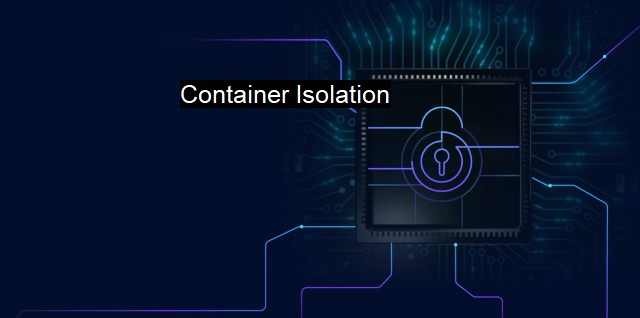What is Container Isolation?
Secure Computing Environments with Container Isolation: A Crucial Cybersecurity Concept for Protecting Distributed Systems
Container isolation is a crucial concept in the domain of cybersecurity and antivirus measures, directly related to the context of system and network protection. To appreciate the importance of container isolation, it is first essential to understand system containers and their role in a host network or system.System containers are isolated user spaces in a host system that allow users to run applications and services without affecting the host's overall state or other containers. each container behaves like a self-sufficient applications manager, maintaining its configurations, libraries, and binaries. these containers are lightweight compared to virtual machines and require fewer system resources due to shared operating systems. Thus, they provide a higher packing density, making them instrumental to operational efficiency and application scalability.
Extrapolating from this architecture, container isolation refers to the fundamental principle of maintaining and enforcing strict boundaries between different containers on a host system. It underpins the primary objective of ensuring that the processes, files, and resources of one container do not interfere with those of another. By deploying container isolation, service providers can enhance system robustness, data privacy, and security.
Container isolation plays a pivotal role by preventing different and inherently disparate workloads from negatively impacting each project. Despite running on the same hardware layer, a container's workload cannot escape its confines and meddle with others, keeping system conflicts to the minimum. This setup mirrors a “sandbox” environment where operations run independently, and even if one container suffers a security breach or is compromised, the adverse effects are effectively quarantined, preventing system-wide proliferation.
Oftentimes, malicious software or unauthorized users exploit system vulnerabilities to gain access. When these undesirable entities surpass system perimeters and proceed to infiltrate additional components, the phenomenon is termed as “lateral movement.” It is one of the most potent attack strategies and can lead to extensive damage if not appropriately mitigated. Container isolation is a stalwart defense strategy against instances of such lateral movements by compartmentalizing system processes and ensuring that container boundaries cannot be penetrated even if one exploits a vulnerability.
Container isolation extends its capacity to antivirus measures by isolating potential threats and damage. The execution of software with questionable origins or low trust scores within a singular, insulated container prevents wider system contamination. This way, even if the software contains malware or executes a harmful process, the host system or other containers remain unaffected.
Container isolation also serves as an efficacy booster for antivirus software. Antiviruses can quarantine threatening files or software, running them in isolated environments to perform virus checks or cleanse them. This practice increases system reliance by ensuring that the antivirus’s operations do not become a cause for security compromise themselves.
Container isolation promotes clean system tests and uncompromised application performance. By isolating different applications and processes within separate containers, technicians can perform unbiased compatibility and scalability tests to verify the parameters and limits of safety, encouraging the identification and resolution of potential security issues.
While this discussion paints a rosy picture, achieving robust container isolation also brings critical challenges. Numerous container vulnerabilities can be exploited across the container lifecycle, from design and provisioning to runtime and shutdown. Security misconfigurations in both the host system and individual containers serve as viable loopholes for attackers to exploit. Therefore, ensuring rigorous container isolation requires concerted efforts in designing, monitoring, and managing the container security lifecycle.
Container isolation plays an indispensable role in advancing cybersecurity norms and antivirus measures. By imposing strict boundaries between different system aspects and maintaining an environment conducive to safety, that guarantees isolation of threats from the main system, container isolation demonstrates its value as a cornerstone in the foundation of total system and data protection.

Container Isolation FAQs
What is container isolation in cybersecurity?
Container isolation is a security feature that enables isolating applications and services running in containers from the host system and other containers. This way, even if a container is compromised, the damage is limited to the container only and cannot spread to other parts of the system.How does container isolation help in antivirus protection?
Container isolation makes it easier for antivirus software to scan and detect malware or viruses in individual containers without affecting other parts of the system. Antivirus tools can also be deployed within containers to increase their effectiveness in preventing and defending against attacks.How is container isolation different from virtual machines?
Container isolation and virtual machines both provide isolation and security, but they differ in their approach. Containers share the host OS kernel, making them more lightweight and efficient than virtual machines, which require their own OS instance. Also, containers start up and shut down faster than virtual machines, making them more scalable and flexible.What are the best practices for container isolation in cybersecurity?
Some best practices for container isolation include using the latest container images, applying security patches regularly, enforcing strong access controls, monitoring container behavior and network traffic, and limiting the privileges of container images to the minimum necessary to perform their tasks. Also, it's essential to use trusted and reliable container technologies and tools from reputable vendors.| | A | | | B | | | C | | | D | | | E | | | F | | | G | | | H | | | I | | | J | | | K | | | L | | | M | |
| | N | | | O | | | P | | | Q | | | R | | | S | | | T | | | U | | | V | | | W | | | X | | | Y | | | Z | |
| | 1 | | | 2 | | | 3 | | | 4 | | | 7 | | | 8 | | |||||||